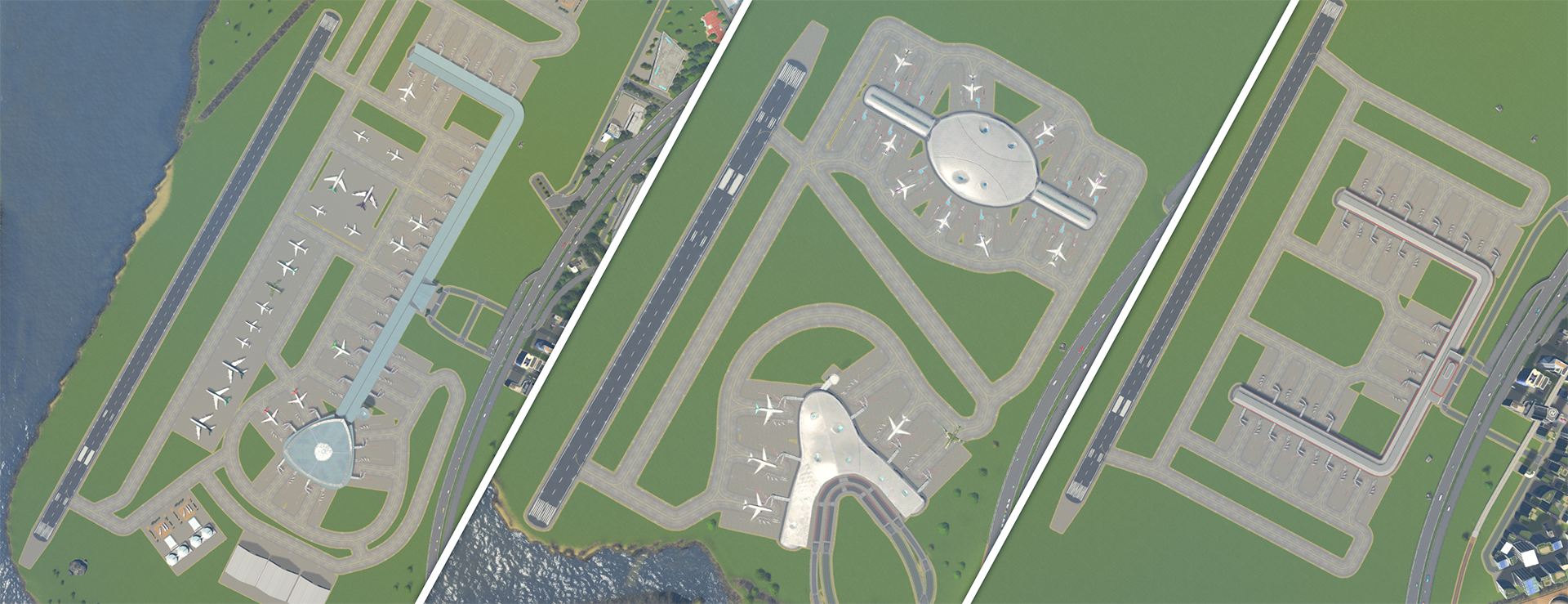Greetings city-builders! I hope you’re ready for another round of Dev Diaries as we prepare for the release of Cities: Skylines - Airports, the expansion that was announced on the
10th of December 2021! If you haven’t already, check out the trailer here or watch it below.
 Cities: Skylines Airports
Cities: Skylines Airports is an expansion in which you design your own airport and grow it from a small local transit point to a massive international hub buzzing with life. It’s modular, using special concourse networks to connect each building, which allows for a lot of creative freedom and flexibility, meaning you can build an airport in many different shapes and sizes to fit your city!
Airports expansion lands in stores on the
25th of January and to ensure a smooth arrival we have prepared these Dev Diaries covering each new feature, so please sit back and enjoy!
 Shape your airport to fit your city
Shape your airport to fit your city Create your Airport Airports use the Area Tool which can be found in the Districts and Areas menu, and becomes available when your city reaches Milestone 4. It works very similar to Districts and other Area Tools with one exception: It flattens the ground and removes trees in preparation for your airport, adding a landscaping cost and affecting the amount of soil available to you. The 3 new maps added in Airports feature a lot of suitable, but more on those in a later Dev Diary.
 The Airport Area tool prepares the terrain for your airport
The Airport Area tool prepares the terrain for your airportOnce you are satisfied with the area, it’s time to start actually building your airport! All the items you need are in the Public Transport menu under the new Airport Area tab. A functional airport needs a
terminal building, a
plane stand, and a
runway, and
taxiways connecting the plane stand to the runway. The Airport Area has a handy checklist alerting you to anything you’re missing to get your airport going!
 Go through your checklist before takeoff
Go through your checklist before takeoffThe first thing your new Airport Area needs is
a terminal. Once placed it unlocks the additional buildings and the concourse, runway and taxiway networks needed to create your airport.
Concourse networks serve as a connection between terminals and
plane stands, which are placed along the concourse.
Next, the airport needs
a runway for planes to land and take off. It works differently than most networks as it has both a minimum length and cannot be extended after placing it, so make it as long as you want it right away.
Taxiways connect the runway and the plane stands in a one-way loop.
 A modular airport in its simplest form
A modular airport in its simplest form Choose your style There are 3 different styles you can choose from when building your airport: Classic, Modern and Ultra Modern. Each style has 3 different sizes of terminal buildings, a concourse network, a control tower and a concourse hub with built-in metro for those very large airports, and all 3 style options are available at level 1.
An airport can have multiple terminal buildings, which function as different entry and exit points for citizens. This lets you expand your airport as it grows, with different terminals able to handle different amounts of traffic. For a busy airport you might want to use the 2 story terminal option, which splits arrivals and departures and has a dedicated lane for buses and taxis to drop off or pick up passengers.
 Pick your favorite style or mix all of them in one airport
Pick your favorite style or mix all of them in one airport Airport Info Panel Selecting the Airport Area name or using the Airport Area Info button after selecting a terminal brings up the Airport Info Panel, which shows all the relevant information for your airport: Level, passenger count, attractiveness score, income and expenses, and much more.
 The Airport Area Info Panel gives a quick overview of your airport
The Airport Area Info Panel gives a quick overview of your airportLike most public transport you will find an airport to be a costly investment with little direct income. Instead, it brings in tourists to your city, who visit attractions and commercial buildings, adding to your income. And the attractiveness of the airport also increases the City Attractiveness, which helps bring in even more tourists!
The
Policies tab lets you apply area-specific policies, like
Hotel Discounts, which gives your airport a direct increase in attractiveness,
Great Maintenance, which adds a Land Value bonus to the whole airport, and
Car Rentals, which encourages tourists to use cars but may cause increased traffic.
With the basics of creating an Airport Area covered, we come to the end of this Dev Diary. We hope you enjoyed this first look at Cities: Skylines Airports, which arrives in stores on the
25th of January, and don’t forget to check in on Friday at 4 PM CET / 7 AM PST when we explore Airport Levels & Public Transport Links!
Last but not least check out the video tutorial by CityPlannerPlays and don't forget to subscribe to our YouTube channel for more!










